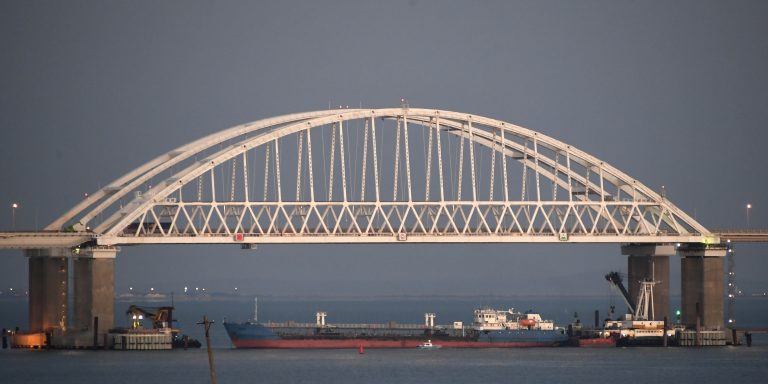INTELBRIEF
November 27, 2018
IntelBrief: A Dramatic Escalation Between Russia and Ukraine

- After months of increasing restrictions, Russia recently blockaded the Sea of Azov at the Kerch Strait, denying Ukrainian ships the ability to enter.
- Russia fired upon and seized two Ukrainian gunboats and a tugboat as they attempted to sail from Odessa to Mariupol, with an unknown number of Ukrainian sailors wounded in the process.
- Moscow blockaded the Kerch Strait by anchoring a large tanker underneath the new bridge that spans the waterway, located between the illegally-annexed Crimea Peninsula and Russia.
- Kiev approved martial law while NATO leaders and the UN Security Council held emergency talks, respectively, to discuss the situation and decide upon the appropriate response to stem the simmering crisis.
.
It may never be known why Russia chose this specific time to escalate the proxy war it has waged against Ukraine since 2014 into a direct naval clash that threatens to accelerate a low-intensity conflict into a more comprehensive conflagration. Some speculate that this is Vladimir Putin taking advantage of a divided and distracted NATO to probe the alliance’s reaction. The tensions in the Sea of Azov, crucial to Ukraine’s economy and sovereignty, have been building for years, following Russia’s illegal annexation of the Crimean Peninsula in 2014. To further solidify its presence, in May 2018, Russia opened a bridge over Kerch Strait and has since steadily increased pressure on Ukrainian naval and civilian vessels. As it has done at every stage of the Ukrainian conflict to date, Moscow falsely claimed to be the victim yet again, even as it ramps up its aggressive military posture vis-à-vis Kiev.
On November 25, 2018, two Ukrainian patrol boats, the Berdyansk and Nikopol, and the tugboat Yana Kapu, attempted to transit the Kerch Strait, moving from Odessa on the Black Sea side of the strait to Mariupol in the Sea of Azov. Both of these ports are crucial to Ukraine’s economy and security. According to a 2003 treaty between Ukraine and Russia, both countries enjoy freedom of movement into and across the Sea of Azov. However, for months, Russia has been detaining ships and inspecting cargoes, insisting that these moves are a necessary security precaution to prevent sabotage against the Kerch Bridge. While Kiev has lodged objections over the restrictions, Moscow has responded in typical fashion, with claims of a Western-led conspiracy backing Ukraine in a quest to subvert Russian influence in the region.
As the three Ukrainian vessels approached the Kerch Strait, they were fired upon and then rammed by a Russian vessel. Russia had anchored a large tanker directly under the bridge, impeding lawful transit between the Black Sea and The Sea of Azov. During the confrontation, an unknown number of Ukrainian sailors were injured. Russia then seized all three vessels and are holding them and their crew in Kerch. Moscow admitted to the confrontation but said that the vessels had entered Russian ‘territorial waters’ in a ‘pre-planned’ confrontation. This statement suggests that Russia now considers the strait as its territorial waters, another illegal move.In response, and in a hint of how serious Ukraine considers this incident, Kiev moved forward with imposing martial law, which it hasn’t done at any time during the ongoing conflict with Russia. Ukraine’s military was also put on high alert. Russia has denounced a protest outside its embassy in Kiev in which a Russian embassy vehicle was torched, and continues to deflect blame for the current skirmish to Ukraine, claiming that Russia is merely protecting its rights. The European Union denounced the latest aggression from the Kremlin, and the UN Security Council held an emergency meeting yesterday, on November 26.
As with all things Russia, the U.S. reaction has been muddled and ambiguous, stoking concern from American allies. There is a clear divide between how Congress sees the issue of continued Russian provocation and how the White House interprets this same threat. President Trump has failed to strongly condemn Moscow for its annexation of Crimea (the first such illegal land grab in Europe since the end of World War Two), literally blaming the Obama administration for ‘allowing’ it to happen instead of Moscow for engineering it. At the same time Russia was firing upon the Ukrainian vessels, President Trump was tweeting that Europe was ripping off the U.S. in terms of defense, and needed to pay its ‘fair share for Military Protection,’ even though U.S. security cooperation has been a hallmark of post-war relations since 1945. These recent actions by the Russians cannot simply be dismissed as part of the Russian ‘gray zone’ strategy or just another of its hybrid capabilities. Firing on naval vessels crosses the threshold from gray zone actions to the kinetic side of the warfare spectrum. Unless the United States and other world powers step in to encourage a political settlement to the ongoing crisis in Ukraine, similar incidents to what occurred in Kerch are inevitable and will only serve to increase the likelihood that conflict will escalate again in the near future, with predictably deadly results.
.
For tailored research and analysis, please contact: info@thesoufancenter.org
[video width="960" height="540" mp4="https://thesoufancenter.org/wp-content/uploads/2018/11/IB-1127.mp4" poster="https://thesoufancenter.org/wp-content/uploads/2018/11/AP_18329717144599.jpg"][/video]